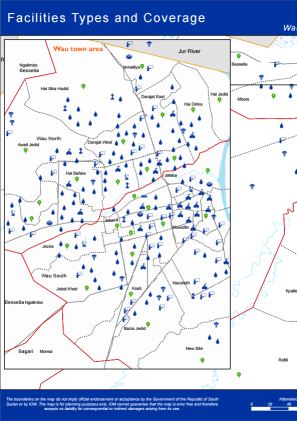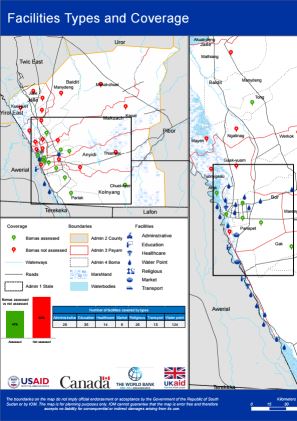-
Countries
-
Data and Analysis
-
Special Focus
-
Crisis Responses
Village Assessment Survey Report
Country
Title Standard
South Sudan — {LOCATION} Village Assessment Survey ({DATE})
Operation
Type
Component
Domain
Confidential

Contact
DTM South Sudan, SouthSudanDTM@iom.int
Language
English
Location
South Sudan
Period Covered
Aug 01 2019
Nov 30 2019
Activity
- Mobility Tracking
- Site Assessment
This atlas contains 17 individual maps as part of the Wau, Rubkona And Bor South Village Assessment Survey (August - November 2019). DTM mapped the presence and quality of available facilities, infrastructure and services:
- Facilities Types and Coverage
- Education Facilities by Functionality
- School Curriculum
- Healthcare Facilities by Functionality
- Improved Water Point Facilities
- Access to Water and Related Conflict
- Access to Water Sources
- Most Common Forms of Sanitation Practices
- Most Common Shelter Types
- Major Livelihood Practices
- Top Three Livelihood Shocks
- Land Ownerships and Land Allocations to returnees
- Challenges that Affect Farming
- Access to Major Markets
- External Threats, Violations and Risks
- Internal Threats, Violations and Risks
- Presence of Mines and Demining Activities

Contact
DTM South Sudan, SouthSudanDTM@iom.int
Language
English
Location
South Sudan
Period Covered
Aug 01 2019
Nov 30 2019
Activity
- Mobility Tracking
- Site Assessment
This atlas contains 17 individual maps as part of the Wau, Rubkona And Bor South Village Assessment Survey (August - November 2019). DTM mapped the presence and quality of available facilities, infrastructure and services:
- Facilities Types and Coverage
- Education Facilities by Functionality
- School Curriculum
- Healthcare Facilities by Functionality
- Improved Water Point Facilities
- Access to Water and Related Conflict
- Access to Water Sources
- Most Common Forms of Sanitation Practices
- Most Common Shelter Types
- Major Livelihood Practices
- Top Three Livelihood Shocks
- Land Ownerships and Land Allocations to returnees
- Challenges that Affect Farming
- Access to Major Markets
- External Threats, Violations and Risks
- Internal Threats, Violations and Risks
- Presence of Mines and Demining Activities

Contact
DTM South Sudan, SouthSudanDTM@iom.int
Language
English
Location
South Sudan
Period Covered
Aug 01 2019
Nov 30 2019
Activity
- Village Assessment
Between August and November 2019, IOM's Displacement Tracking Matrix (DTM) conducted Village Assessment Survey (VAS) in Wau, Rubkona and Bor South counties assessing a total of 63 bomas (13 in Bor South, 11 in Rubkona and 39 in Wau) and carrying key informant interviews at 191 educational facilities and 42 health facilities. In addition to this, 1,147 facilities and services including water points, markets, fishing areas, etc. were also mapped.
Datasets:
- Boma/Area Mapping Survey Questionnaire – Dataset
- Education Technical Questionnaire - Dataset
- Health Technical Questionnaire – Dataset
- Facility, Infrastructure and Service Mapping - Dataset
Key findings:
- In a significant number of bomas (42 of 63 bomas), status of majority of the houses was reported as partially damaged, in 9 bomas majority of the houses were completely damaged while in two bomas makeshift shelters were reported as the most common form of shelters in the areas.
- Findings show limited instances of bomas where land has been allocated for returnees (only 9 bomas out of 63 assessed).
- Conflict over water was reported in a sizeable majority of the bomas (38 of 63 bomas). Primarily owing to the distance to the water source and insufficient water quantity, in over half the assessed bomas (34 of 63 bomas), water sources were not accessible to all households residing in the bomas.
- Respondents states that none of the bomas were equipped with any credit and financing infrastructure needed to support the farmers, often leaving them without the capital for purchasing necessary tools and equipment.
- Rainwater is the most commonly used source of irrigation, making farmers susceptible to rain patterns. Erratic or delayed rains that may result in poor or no harvests, while heavy rains and flooding can waterlog fields and destroy stocks.
- Out of the 191 schools visited, many lack basic amenities such as furniture (n=150), classrooms (n=104), drinking water (n=115), non-drinking water (n=130) and school latrines (n=119) which are found to be either completely absent or insufficient.
- A significant number of bomas (35 out of 63) reported access to health facilities, where, in most cases respondents expressed dissatisfaction (20 of 35) with the existing facilities. This was mainly related to non-availability of medicine, lack of qualified personnel and selective operational days.
- Boma courts play an integral role resolving community conflicts and legal disputes; in comparison to traditional courts that were reported in 54 of 63 bomas, judicial courts were reported in only 19 of 63 bomas. In over half the bomas assessed (34 of 63 bomas), no police posts/police stations were reported.
Pagination
- Previous page
- Page 2
